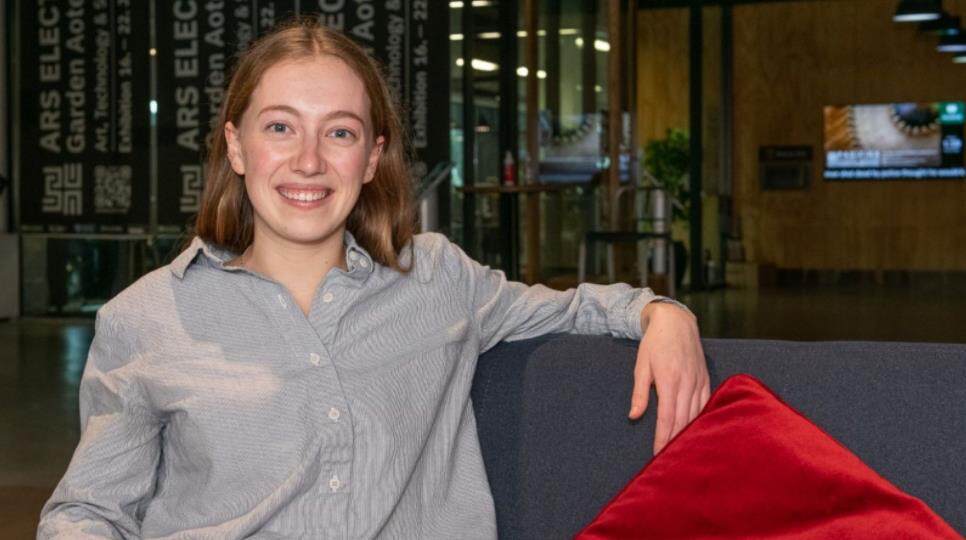Master of Architecture student Eloise Blewden was recently named Future Thinker of the year 2022 by the New Zealand Green Building Council.


We talked with her about what led her to study architecture, how she came to enter the New Zealand Green Building Council’s competition, and how New Zealand’s schools can teach climate change action through architecture.
What was your winning entry to the NZGBC Future Thinker of the Year competition about?
My entry for the NZGBC Future Thinker of the Year role focused on education as a key solution to the environmental challenges we are facing. I focused on education in three areas: our schools, our buildings, and our architecture curriculums. Schools are a great place to start as they are at the centre of our communities.
Across Aotearoa, we have a plethora of poorly functioning school buildings. To support schools to transition to a low-carbon future, I developed an Excel-based, school-specific carbon emission calculator that allows schools to input data for categories such as fuel, energy, waste, water use, and travel. The calculator is supported by a toolbox that provides behavioural and material actions that schools can undertake to reduce their carbon emissions and improve their thermal comfort.
From here, the buildings and facilities children learn in can become tools to teach tamariki and our communities how we can construct and operate our buildings with minimal impact. Applying these same concepts to homes and buildings will provide a more durable, long-term approach to achieving net-zero. Adaptions to our buildings go hand in hand with our everyday behaviour.
My entry also focused on teaching our rangatahi to design with sustainability as a priority. We have the knowledge and skills on how to design and build better for our people and planet. So let’s extend manaakitanga and teach our next generation of architects how to design and build this way.
What is your academic and professional background?Architecture is an amalgamation of many subjects I am passionate about, which also include design, history, wellbeing, sustainability, art, and science. It is a direct reflection of social, environmental, economic, and political issues, and it impacts every one of us every day.
Over the past summer, I undertook a research project with WSP and Victoria University of Wellington looking into carbon-neutral schools and how we can support schools to calculate and reduce their emissions. Through this project, I developed two tools to support New Zealand state schools.
To pass on my learnings and passion for passive design and low-carbon design, I have been tutoring second-year students at Victoria University in Human Environmental Science, and soon will be tutoring Introduction to Environmental Design Science. These papers are invaluable for our next generation of architects and building scientists on how we can design with consideration for the
environment.
What drew you to apply for NZGBC’s Future Thinker of the Year competition?
I have always been engaged in sustainability and the impact our everyday actions have on our environment. Our built environment has a large role to play in combating climate change, and NZGBC are leading the way in the New Zealand green building industry.
The NZGBC Future Thinkers platform allows me to engage with people who are passionate about better, healthier, and more sustainable buildings. I applied for their Future Thinker of the Year award to help foster the connection between the built environment industry and current students to inspire change for young people entering the industry.
What are your recommendations for our built environment sector?
The most basic concept of sustainability we all learnt at primary school: reduce, reuse, recycle.
Our land and resources are taonga and we should treat them with kaitiakitanga. Let’s reduce our building footprints, and design smaller buildings. Let’s reduce the amount of non-renewable resources we are using. Let’s use methods of standardised sizing and prefabrication to reduce construction waste. Let’s stop demolishing buildings and building new structures and instead learn to adapt and retrofit our existing stock. We should also design buildings so that they can be repurposed or deconstructed at the end of their life, including recycling materials where we can.
Sustainability doesn’t have to be overwhelming and complicated; it can be stripped back to these fundamental concepts.
There should be two directions from which we are tackling net-zero carbon. From the top-down, there needs to be policy change, and extensive resources and education provided. For schools specifically, our government should be improving the buildings tamariki learn in, improving the education for sustainability curriculum, and providing the skills and resources on how to operate school buildings sustainably. These changeswill foster intergenerational change, providing a more durable, long-term approach to achieving net-zero.
Who would you like to thank and why?
I would like to thank my summer research supervisors Professor Robyn Phipps, Duncan Bright, and Noel Guilfoyle. The support and expertise they provided me during the carbon-neutral schools project was invaluable.
I would also like to thank the New Zealand Green Building Council, Mott MacDonald, and Warren and Mahoney for organising the Future Thinker of the Year 2022 competition. It was a privilege to speak at this event alongside such passionate and knowledgeable individuals.
Watch a video of Eloise’s winning entry on the New Zealand Green Building Council’s website.



































